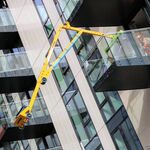tmlittle
Active Member
I think what ShonTron was suggesting was that a stop closer to the middle of town - such as, for instance, the VIA station - would be accessible to more residents by walking or cycling, rather than waiting for a local bus service that doesn't exist. The Casablanca Blvd. stop is deally suited for capturing people heading to Hamilton and Toronto by auto, but is really only accessible without a car to a very small percentage of the community.
It is certainly symptomatic of a bigger problem inside of Metrolinx, and one that has been a concern for a long time. They simply are not able to disengage their thought processes from the automobile, and thus their stations are generally scaled and designed in that way. Huge parking lots, long walking distances from primary destinations or even just from the streets, and long, winding accesses for buses that add far too much time to effectively serve the stations properly.
Dan
This really is a huge problem. It feels like Metrolinx/GO has for decades tried to target a very narrow slice of the population: people who own cars but sometimes don't want to drive them (implicitly, into Toronto). What it does in practice is reinforce the Toronto-centric hub-and-spoke model with few lateral connections, depress potential local transit ridership (as you now need a car to get to the station anyway), and also selects for people who are wealthy enough that they can choose to pay for both car ownership and transit. Most people realistically can only afford one or the other, especially because of the price structure of both -- buying an occasional ticket isn't as cost-effective as owning a monthly pass, and buying a car creates a sunk cost fallacy that makes you more likely to drive it everywhere. The baseline demographics that underpin transit ridership are car-free people: students, seniors, people with disabilities, urban-dwelling professionals, low-income people who can't afford a car. Getting suburbs and smaller cities to switch to transit requires an investment in local networks that allow at least a limited number of people to make the switch, and that doesn't happen through park n rides, it happens through funding local transit. There's a reason why the relatively modest PTIF grants are having such a huge effect with a number of small, rural bus systems starting up, which in practice are just a successor to/replacement for the private bus lines that used to operate throughout Ontario until the 1980s and 1990s.
When you look at suburban GO stations (bus or train), these should really be minor hubs that take advantage of their often-ample station land to have local buses handle transfers, as well as at least some walkable proximity to amenities. Instead they are often total ghost towns that require a cab ride to get to or very careful timing with local transit, and are often pretty disconnected from local transit agencies' networks. The point being missed here is that strengthening transit anywhere strengthens transit everywhere, because the stronger someone's local transit is, the more likely they are to permanently go car-free, and car free people are what underpins transit, period. The goal of the next 20-30 years should be not so much trying to induce drivers to take single trips by transit instead of by car (because that's a niche case that selects for particular demographics), but pre-empting car ownership and driving amongst teens and students (already a process that's matured in many places) and providing enough incentives to take transit (and enough disincentives/discouragement to drive) that people give up their cars altogether and become full-time transit riders.




